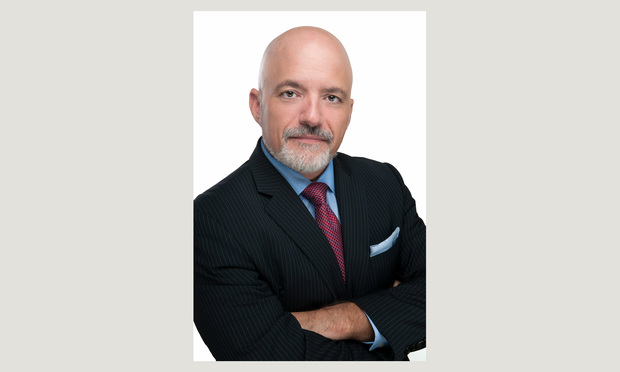Big or Small Firm—Here's What Works to Improve Diversity
Now in my third decade of practicing, I've been fortunate enough to have worked in both Big Law and in smaller firms (like my own). In my experience, Big Law's focus on diversity and inclusion may be capturing all the attention, but smaller firms and boutiques have long led the way on these issues.
July 20, 2020 at 06:00 AM
5 minute read
 Luis Salazar, Salazar Law, Miami
Luis Salazar, Salazar Law, MiamiNow in my third decade of practicing, I've been fortunate enough to have worked in both Big Law and in smaller firms (like my own). In my experience, Big Law's focus on diversity and inclusion may be capturing all the attention, but smaller firms and boutiques have long led the way on these issues. Certainly, with larger firms, the change toward greater diversity has been slow, but the stakes are higher. And yet woman and minority lawyers have been creating and leading smaller, diverse firms that are making inroads into the kind of sophisticated, complex commercial work Big Law enjoys.
Here's the reality of where we stand: according to a 2004 study by the National Association for Law Placement (NALP), in 2004, in law firms with more than 500 attorneys, 5.43% of partners and 17.90% of associates were minorities, while in firms with fewer than 100 attorneys, 4.44% of partners and 11.35% of associates were lawyers of color. As of 2019, NALP is reporting that, in firms with over 500 lawyers, 8% of minorities were partners and 24.38% were associates, while in firms with fewer than 100 attorneys, 7.18% of partners and 18.39% of associates were lawyers of color. So, regardless of the size of the firm, there is still much to do. Law firms are only now starting to achieve genuine progress through real commitment, concrete action and long-term engagement. In my experience, here's what is working.
Giving Diversity a Seat at the Table. For too long, managing partners touted "diversity initiatives" at their firms like badges of honor. But these initiatives failed to yield meaningful change. We are now seeing real results because law firms seeking change have given a voice to these initiatives through empowered committees, and chief diversity and inclusion officers. Having an internal champion, especially with access to, or sitting on, the "executive committee," is helping keep diversity and inclusion front and center.
Looking at the Actual Data. Peter Drucker is right—you can't manage what you don't measure. It was easy for law firms to claim they valued diversity when they didn't have to bother to disclose exactly how diverse their firms actually were. But diversity reporting has now become both public and widespread. To cite one example, The American Lawyer now publishes its "Diversity Scorecard" annually, and, to cite another, in-house counsel are demanding their outside counsel provide statistical reports on diverse recruiting and staffing of their matters. Looking at the actual data has led to a push for actual, measurable diversity progress. In one recent article, an AmLaw 100 chief diversity officer wrote that he received over 100 such surveys and report cards last year alone.
Benchmarking. Closely related, benchmarking has forced law firms to prove they are making the changes they so often paid lip service to. The Diversity Lab's Mansfield Rule, for example, challenges participating law firms to ensure that women, minority, disabled and LGBTQ+ lawyers make up at least 30% of the candidate pool for equity partner and leadership positions. Over 117 firms, including many of the AmLaw 100, are participating this year.
Connect With Other Firms. While diversity and inclusion can give firms a competitive advantage, many firms are building alliances to promote diversity goals. This is especially so for smaller firms. For example, Miami's own León Cosgrove and Alvarez, Arrieta & Diaz-Silveira launched their Women's Initiative Group to create meaningful networking opportunities, enhance business development skills, and bolster institutional support to address the unique obstacles faced by women in the legal profession.
Partnering With Professional Associations. Smaller, diverse firms often lack access to corporate general counsel. But more and more, minority bar and professional associations are creating successful platforms for their members to network with general counsel of major U.S. companies, seeking to make their outside counsel more diverse. For example, the National Hispanic Bar Association's Corporate Counsel Conference is specifically geared towards this goal, offering CLE on topics of interest to corporate counsel and extensive networking events for HNBA members.
Not Just Numbers, but Inclusion. Historically, diversity efforts have focused on recruitment, which helped bring more woman and minorities to law firms. But these newly recruited diverse lawyers often left these firms due to a lack of opportunities for growth and advancement. To address this issue, firms are broadening their efforts from diversity to inclusion, increasing professional opportunities and training. Many firms are encouraging the creation of women, minority, and LGBTQ+ affinity groups.
These kind of concrete efforts are driving action and accountability. They are moving law firms away from industry's long-standing habit of claiming to embrace diversity but doing little to make it a reality. These effective programs are beginning to have a significant impact on diversity efforts at law firms big and small.
Luis Salazar is the founder of Salazar Law, a minority-owned boutique litigation and bankruptcy law firm.
This content has been archived. It is available through our partners, LexisNexis® and Bloomberg Law.
To view this content, please continue to their sites.
Not a Lexis Subscriber?
Subscribe Now
Not a Bloomberg Law Subscriber?
Subscribe Now
NOT FOR REPRINT
© 2025 ALM Global, LLC, All Rights Reserved. Request academic re-use from www.copyright.com. All other uses, submit a request to [email protected]. For more information visit Asset & Logo Licensing.
You Might Like
View All
Don’t Forget the Owner’s Manual: A Guide to Proving Liability Through Manufacturers’ Warnings and Instructions
5 minute read


Leveraging the Power of Local Chambers of Commerce: A Second-Career Lawyer’s Guide to Building a Thriving Practice
5 minute readTrending Stories
Who Got The Work
J. Brugh Lower of Gibbons has entered an appearance for industrial equipment supplier Devco Corporation in a pending trademark infringement lawsuit. The suit, accusing the defendant of selling knock-off Graco products, was filed Dec. 18 in New Jersey District Court by Rivkin Radler on behalf of Graco Inc. and Graco Minnesota. The case, assigned to U.S. District Judge Zahid N. Quraishi, is 3:24-cv-11294, Graco Inc. et al v. Devco Corporation.
Who Got The Work
Rebecca Maller-Stein and Kent A. Yalowitz of Arnold & Porter Kaye Scholer have entered their appearances for Hanaco Venture Capital and its executives, Lior Prosor and David Frankel, in a pending securities lawsuit. The action, filed on Dec. 24 in New York Southern District Court by Zell, Aron & Co. on behalf of Goldeneye Advisors, accuses the defendants of negligently and fraudulently managing the plaintiff's $1 million investment. The case, assigned to U.S. District Judge Vernon S. Broderick, is 1:24-cv-09918, Goldeneye Advisors, LLC v. Hanaco Venture Capital, Ltd. et al.
Who Got The Work
Attorneys from A&O Shearman has stepped in as defense counsel for Toronto-Dominion Bank and other defendants in a pending securities class action. The suit, filed Dec. 11 in New York Southern District Court by Bleichmar Fonti & Auld, accuses the defendants of concealing the bank's 'pervasive' deficiencies in regards to its compliance with the Bank Secrecy Act and the quality of its anti-money laundering controls. The case, assigned to U.S. District Judge Arun Subramanian, is 1:24-cv-09445, Gonzalez v. The Toronto-Dominion Bank et al.
Who Got The Work
Crown Castle International, a Pennsylvania company providing shared communications infrastructure, has turned to Luke D. Wolf of Gordon Rees Scully Mansukhani to fend off a pending breach-of-contract lawsuit. The court action, filed Nov. 25 in Michigan Eastern District Court by Hooper Hathaway PC on behalf of The Town Residences LLC, accuses Crown Castle of failing to transfer approximately $30,000 in utility payments from T-Mobile in breach of a roof-top lease and assignment agreement. The case, assigned to U.S. District Judge Susan K. Declercq, is 2:24-cv-13131, The Town Residences LLC v. T-Mobile US, Inc. et al.
Who Got The Work
Wilfred P. Coronato and Daniel M. Schwartz of McCarter & English have stepped in as defense counsel to Electrolux Home Products Inc. in a pending product liability lawsuit. The court action, filed Nov. 26 in New York Eastern District Court by Poulos Lopiccolo PC and Nagel Rice LLP on behalf of David Stern, alleges that the defendant's refrigerators’ drawers and shelving repeatedly break and fall apart within months after purchase. The case, assigned to U.S. District Judge Joan M. Azrack, is 2:24-cv-08204, Stern v. Electrolux Home Products, Inc.
Featured Firms
Law Offices of Gary Martin Hays & Associates, P.C.
(470) 294-1674
Law Offices of Mark E. Salomone
(857) 444-6468
Smith & Hassler
(713) 739-1250






